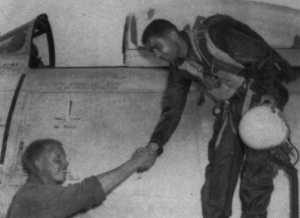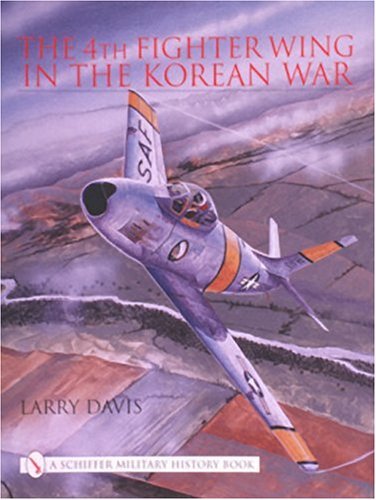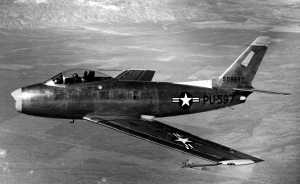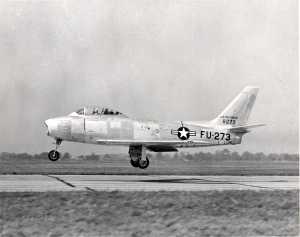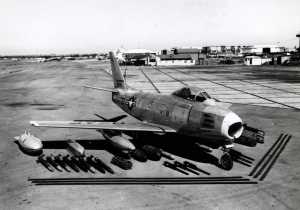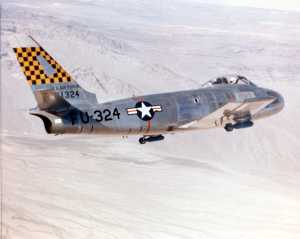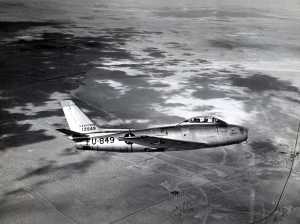Captain Dick Becker
First American Jet ace
By Diego Zampini, Dec. 2004. Updated July 8, 2011.
On November 1950 the outstanding MiG-15 swept-winged jet appeared in the Korean Skies, and the whole aspect of the aerial warfare changed. 1st Lt. Becker was among the pilots who were sent (together with their F-86As) to Japan, and then to Kimpo AB, as part of the Detachment "A" of the 4th FIW. Becker's first blood against the Soviet flown MiG-15s was on December 30, when at about 15:15 hs he claimed to damage a MiG.
Sadly few days later, on January 2, Detachment "A" should withdraw from Kimpo to Taegu AB, because of the fast advance of the Chinese troops, which thanks to the air superiority achieved by the Russian MiG units, forced the UN forces to retreat out of North Korea and also away from Seoul for the second time in less than six months.
It wasn't an easy time either, because the Sabres of the 334th and 336th FIS were tasked to air-to-ground missions, armed with under-wing rockets.
First victory
By early-March the US Army liberated Seoul again, and the Sabres returned to Kimpo. The Soviets made the mistake to send home their experienced MiG pilots, and replaced them with the rookies of the 28th and 72nd GIAP of the 151st IAD. These pilots had fought well against the inferior F-80Cs, F-51Ds and B-29As in November 1950, but now they were no match for the skillful American pilots, and soon the Sabre fliers of the 4th FIW began to beat them up. Dick Becker made his share on March 24 1951, as himself accounted in The 4th Fighter Wing in the Korean War by Larry Davis (page # 130):
"My first victory was never confirmed. We were flying a MiG Sweep to the Yalu. It was my nineteenth mission. I was in Jim Jabara's flight. He was Eagle Red Lead and I was Eagle Red 3. As we entered the area known as MiG Alley in northwest Korea, we spotted a large gaggle of MiGs above us, at least tweny, maybe more. Jim ordered 'Drop tanks!' and the fight was on. But to my dismay, my left drop tank hung up. What to do? Standing orders were to get yourself home if you couldn't drop your tanks. I decided to fight the poor handling and stay with Jabara.
The MiGs broke down into us as westarted climbing. We split their formation right in two. Jim's element took the ten MiGs to our left, my element took the ten MiGs to our right. The airplane was very heavy because of the hung left tank, but the MiGs weren't getting away! Wracking the Sabre back and forth trying to get one of the MiGs in my sights. I finally got one to hold still just long enough. I pulled in behind him and gave him a long burst. The MiG stopped, smoking heavily. Then he went into a flat spin at about 18,000 feet. I followed him down to about 14,000 then had to break off due to other MiGs that were plenty mad at me.
The MiG disappeared into the cloud deck at about 5,000 feet. Two other F-86 flights were coming down to help us and saw the MiG go into the cloud deck streaming smoke and obviously out of control. But no one saw him crash.
I wrote up the report claiming a victory, and shot it off the 5th Air Force Headquarters, confident that I would be awarded my first 'kill'. Wrong! A few days later the claim was returned from 5th AF - disallowed. It would go down as a 'Probable' since no one had followed it down to see it crash. Neither I, Jabara, nor anyone else that saw that MiG going down, had any doubts it was a goner. But ..."
In this case, the 5th AF HQ indeed was WRONG. Becker actually shot down a MiG that day: the Soviet archives released in the 1990s proved that 1st Lt. Becker struck the aircraft of Y. Savinov (72nd GIAP), who was killed in the cockpit of his MiG by the bullets fired by Becker's Sabre, and crashed to his death.
Ironically, his first "official" victory wasn't so: on April 22 the 334th FIS was involved in a big furball against the MiGs of the 196th IAP, and again 1st Lt. Becker was flying as secondary leader of Captain Jabara, when the aggressive "Cigar's Kid" (Jabara's nickname) jumped a group of four MiGs while they were still climbing. James Jabara had no problem forcing the pilot of the MiG #2 (Y. N. Samusin) to bail out, as Richard Becker shoot at the MiG #1, flown by the commander of the 3rd Eskadrylya (Squadron) of the 196th IAP, Kapetan Nikolay Shelamonov. Becker saw his tracers hitting the MiG, which began to smoke and entered in a spin. When he returned to Kimpo he claimed a MiG kill and this time was awarded with it. But this time both Becker and the 5th AF HQ were wrong: Nikolay Shelamonov was a very experienced jet pilot who was credited with 5 victories against US aircraft in Korea (three of them, one RB-45C, one F-84E and one F-51D, match with USAF loss records), and actually fooled Becker - he knew how to enter in an apparently uncontrolled spin but later to regain control, and that is what he did that day. Anyway, it took several days the Soviet ground crews in Antung to repair Shelamonov's MiG, and the Russian airman always admitted that he was very fortunate to survive this encounter. The 196th IAP was led by who would become the Top Ace of the Korean War, Yevgeny Pepelyayev, and one of the elite units of the VVS (Soviet Air Force). So, certainly to seriously damage the MiG of such an skillful adversary was indeed quite an achievement anyway. But there was a price to pay: that day another of Pepelyayev's men, Fiodor Shebanov, damaged beyond repair the F-86A BuNo 48-232.
There is no doubts about his next MiG kill: On July 8 1951, while covering a raid of B-29s against the North Korean capital, Pyongyang, his flight surprised a group of low-flying MiGs heading to the bombers, unaware of their presence. That was too much advantage for a natural hunter like him, and he didn't waste the chance; few seconds later, at 11:13 hs, the Soviet flier Kapetan P. P. Pavlovsky was ejecting of his burning MiG-15, which crashed in a orange ball of fire 1 mile S of Pyongyang. That was a good days for the Sabre pilots - few minutes earlier Colonel Francis Gabreski scored his first victory of the Korean War, the MiG of Starshii Leitenant A. A. Obukhov (523rd IAP), who perished.
But Becker's most successful day was August 19 1951. At 10:54 hs began
a big meleé
between the 334th and 335th FIS against the MiG-15s of the 18th
GIAP, and
during twenty minutes both sides fought each other without achieving a
distinct advantage. Then arrived the flight led by Richard Becker,
and the
stalemate was broken; in a matter of few minutes between 11:15 and
11:21 two
MiGs were plunging in flames to the ground and two Russian pilots -Kapetan
V.
A. Sohan and Starshii Leitenant (1st.Lt.) Y. T. Kondrashov-
were hanging
in their parachutes, all because of Dick. It was after his deed in this
air
combat when he received his nickname: Dick "MiG Wrecker" Becker.
First American Ace of the Korean War
At noon on September 9 1951, again the 334th and 335th FIS engaged Soviet flown MiGs in fight, this time the 196th IAP. The recently promoted Captain Richard Samuel Becker recalled the furball (The 4th Fighter Wing in the Korean War, pages # 130-131):
"I was leading a flight of six F-86s as Eagle Blue Leader. Ray Barton and Bob Harper were leading the other elements. We were patrolling the Sinuiju/Anju area in northwestern Korea - the heart of MiG Alley. Shortly after arriving in the area, I sighted a formation of about thirty MiGs sitting high on their perch above us.
I called my squadron CO and told him about the MiGs, then ordered my guys to drop tanks, all the while turning and climbing toward the MiG formation. As we were climbing to attack the first bunch of MiGs. I suddenly caught sight of another MiG formation that was diving on us - right through their own formation!
I had my guys hold their positions as the MiGs started to bore in for the kill. Coming at us head-on. I waited until the last second before opening fire. The MiGs broke in all directions. And my flight followed. All three elements turned and started chasing the MiGs. Barton and Harper's elements went one way, I went another.
I rolled out at 39,000 feet and began looking around. I was alone! My wingman had gotten lost somewhere in the melee. I started to make a hasty retreat since I had no wingman to cover my tail. Then I noticed another twelve MiGs entering the area about 3,000 feet bellow me. Without even thinking about it, I pulled around to get a little advantage, and dove on the Russian formation.
One against twelve! Not too good of odds, I thought. But the MiGs were even more shook than I was by the way I jumped on them. They were probably thinking 'What kind of maniac is this?' The MiGs broke in every direction, and no one was flying anyone's wing. I pulled in behind one of the MiGs that was all alone, lined him up with the pipper, and pulled the trigger. The MiG stopped suddenly, the pilot ejected, and the MiG exploded. Scratch One!
There were still plenty of MiGs around and I soon found another loner trying to get out of my way. I fired on him but missed. He dove away and headed north. I continued this pattern of jumping on any MiG in the area, squeeze off a few rounds, then break away. At about the same moment, both the MiGs and my fuel were gone.
I turned south, got as high as possible, and started for home. When I landed, there was a welcoming committee waiting for me. The kill was my 5th, making me the second ace in the Korean War."
Becker's fifth victim was Starshii Leitenant Andriushko, who bailed out and landed safe and sound. According to the official USAF version of the Korean War, Richard Becker was the second ace of the war because James Jabara was the first, achieving such title on May 20 1951. But, if you read the article devoted to James Jabara in this website, you will find out that he did not shot down 6 MiGs in his first combat tour, instead he only shot down 4. So, Jabara became ace only in his second tour, and he wasn't either the first ace of the Korean War, nor the first jet-vs-jet ace.
| Richard Becker's aerial victories in Korea, all
were MiG-15s. He flew F-86's with the 334th FIS, 4th FIW |
|||||
|---|---|---|---|---|---|
| Rank | Aircraft | Date | Victim | Enemy pilot & status | Enemy Unit |
| 1st Lt. | F-86A #49-1257 | 24 March 1951 | MiG-15 | Y. Savinov - KIA | 72 GIAP/151 IAD |
| 1st Lt. | F-86A #49-1109 | 22 April 1951 | MiG-15 | N. Shelamonov (damaged) | 196 IAP/324 IAD |
| 1st Lt. | F-86A #49-1109 | 8 July 1951 | MiG-15bis | P. P. Pavlovsky | 523 IAP/303 IAD |
| 1st Lt. | F-86A #49-1257 | 19 August 1951 | MiG-15bis | V. A. Sohan | 18 GIAP/303 IAD |
| 1st Lt. | F-86A #49-1257 | 19 August 1951 | MiG-15bis | Y. T. Kondrashov | 18 GIAP/303 IAD |
| Capt. | F-86A #49-1257 | 9 September 1951 | MiG-15bis | Andriushko | 196 IAP/324 IAD |
As a matter of fact, the pilot who had the honor to become THE FIRST ACE OF THE KOREAN WAR and THE FIRST JET-VS-JET ACE is not American, but Soviet (actually, Ukrainian): Sergei M. Kramarenko. Kapetan Kramarenko achieved such deed on July 29 1951, and the second ace of the Korean War was another Russian MiG-15 pilot, Nikolai V. Sutyagin, who scored his 5th victory confirmed by UN records on August 25 1951. Dick Becker is however, the third ace of the Korean War, and also the first American pilot who scored 5 victories confirmed by the Russian archives, and due to all were MiG-15 jet fighters, there is no doubt that RICHARD S. BECKER WAS BOTH THE FIRST AMERICAN ACE OF THE KOREAN WAR AND THE FIRST AMERICAN JET-VS-JET ACE.
Captain Becker felt very frustrated when he was immediately grounded after his 5th MiG kill and was sent back to USA. As he himself accounted (The 4th Fighter Wing in the Korean War, page # 132):
"My final 'score' was five victories, one probable, and two damaged, not bad for only 82 missions. Within an hour after both 'Hoot' and I landed at K-14, we received telegrams grounding us from any further combat. We were ordered back to the States. 'But I still have eighteen missions to fly!', I complained. And Jabara had flown almost 125! Didn't matter. Hoot and I were on our way home two days later. I was back in the States on 23 September, and ended up assigned to the 5th FIS at McGuire AFB flying F-94Bs!"
The 5th AF commanders realized that if Becker keep on flying and was killed or captured, they would lost one of their most valuable propaganda jewels, so they wanted him back in USA as soon as possible. The unfortunate Becker fell prey of the war propaganda machinery, and so happened to many other American aces like Joseph McConnell and Manuel "Pete" Fernández Jr.
The 4th Fighter Wing in the Korean War by Larry Davis (Schiffer Publishing Ltd, 2001). Certainly an excellent book with a lot of research made in USAF records and interviews to American veterans. It includes lots of Color and B&W photographs of Sabres and their pilots (some of them not previously released), including good quality photos of most of the aces of the 4th FIW.The Chapters 8 ("The Aces Talk") and 9 ("MiG Killers and Wingmen") are a "must" for aviation fans. They contains a lot of testimonies of aces like Dick Becker, "Bones" Marshall, Harrison Thyng, Bill Lilley and Vermont Garrison.
The only missing part in this book is that, almost 10 years later of the release of the Russian archives of the Soviet-age, the author performed a very poor research in the Russian side of the Korean War. One have the hope that this shortcoming will be solved in future works of this talented author.
Sources:
- The 4th Fighter Wing in the Korean War, by Larry Davis, Schiffer Publishing Ltd, 2001.
- MiG Alley: Sabres Vs. MiGs Over Korea, D. McLaren & W. Thompson, Specialty Press, 2002.
- Red Wings over the Yalu: China, the Soviet Union, and the Air War in Korea by Dr. Xiaoming Zhang & Joseph G. Dawson. Texas a & M University Military History Series, 2002 ( courtesy of my Japanese friend Naoaki Ooishi).
- Crimson Sky, by John R. Bruning, Brassey's Inc; 1999.
- Sabre jets over Korea: A first hand account, by Douglas K. Evans, Tab Books 1984.
- US Post World War 2 Victory Credits, Frank Olynyk, 1999 (courtesy of Thomas Polak).
- Krasnij Dyabolij ha 38-u Paralely (Red Devils over the 38th Parallel), Igor Seidov and Askold German (courtesy of Nikolai Bakalov and Rubén Urribarres), 1998.
- MiGi protiv Seibrov, Yevgeny Pepelyayev, Delta NPP, 2000 (courtesy of Thomas Polak).


